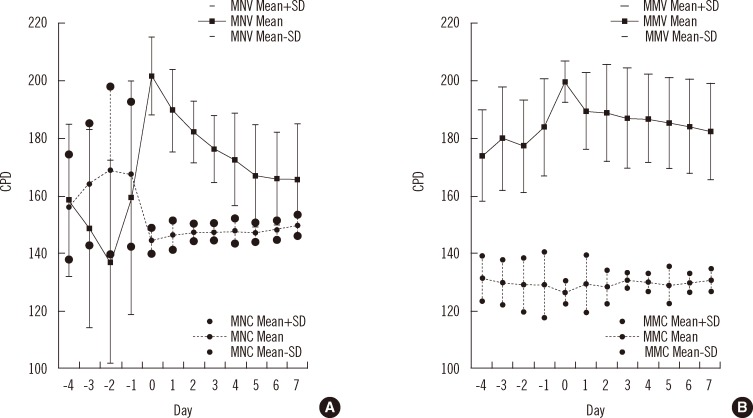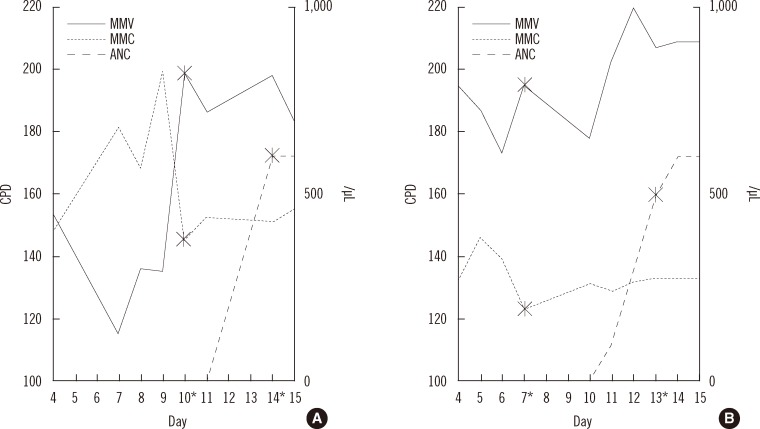Ann Lab Med.
2014 Mar;34(2):92-97. 10.3343/alm.2014.34.2.92.
Novel Markers of Early Neutrophilic and Monocytic Engraftment after Hematopoietic Stem Cell Transplantation
- Affiliations
-
- 1Department of Laboratory Medicine, College of Medicine, The Catholic University of Korea, Seoul, Korea. hankja@catholic.ac.kr
- 2Department of Hematology, College of Medicine, The Catholic University of Korea, Seoul, Korea.
- 3Department of Pediatrics, College of Medicine, The Catholic University of Korea, Seoul, Korea.
- KMID: 1791900
- DOI: http://doi.org/10.3343/alm.2014.34.2.92
Abstract
- BACKGROUND
Numerous studies tried to find new markers that after hematopoietic stem cell transplantation predict engraftment earlier than the conventional marker, absolute neutrophil count (ANC >500/microL). Early engraftment prediction can be achieved by a marker that reflects the release of neutrophils and monocytes into the leukopenic peripheral blood.
METHODS
We analyzed blood cell parameters, including cell population data such as volume, conductivity, and light scatter in 77 patients who underwent HSCT (allogeneic, n=63; autologous, n=11) to detect possible markers.
RESULTS
We identified 2 early engraftment markers of neutrophils (NEUTRO) and monocytes (MONO); a pair of mean-volume-neutrophils (MNV) and mean-conductivity-neutrophils (MNC) for NEUTRO; and a pair of mean-volume-monocytes (MMV) and mean-conductivity-monocytes (MMC) for MONO. The new markers showed distinct patterns for early engraftment wherein 1) on the engraftment day, MNV peaked as MNC notched simultaneously for every case, and 2) MMV peaked as MMC notched simultaneously in most cases. Engraftment was predicted 3.8+/-2.7 days earlier than by ANC in 74 successful engraftment cases by using NEUTRO and/or MONO: 1) 72 cases (97.3%), in which NEUTRO and/or MONO predicted earlier engraftment than ANC, 2) 1 case, in which the 3 markers predicted engraftment on the same day, and 3) 1 case, in which NEUTRO predicted engraftment on the same day as ANC and MONO failed to predict engraftment.
CONCLUSIONS
By analyzing the data from daily complete blood counts, engraftment can be predicted approximately 4 days earlier than ANC >500/microL using NEUTRO as a base marker and MONO as a supplementary marker.
Keyword
MeSH Terms
Figure
Reference
-
1. Clift RA, Buckner CD, Thomas ED, Bensinger WI, Bowden R, Bryant E, et al. Marrow transplantation for chronic myeloid leukemia: a randomized study comparing cyclophosphamide and total body irradiation with busulfan and cyclophosphamide. Blood. 1994; 84:2036–2043. PMID: 8081005.
Article2. Noronha JF, De Souza CA, Vigorito AC, Aranha FJ, Zulli R, Miranda EC, et al. Immature reticulocytes as an early predictor of engraftment in autologous and allogeneic bone marrow transplantation. Clin Lab Haematol. 2003; 25:47–54. PMID: 12542442.
Article3. Flowers CR, Seidenfeld J, Bow EJ, Karten C, Gleason C, Hawley DK, et al. Antimicrobial prophylaxis and outpatient management of fever and neutropenia in adults treated for malignancy: American Society of Clinical Oncology clinical practice guideline. J Clin Oncol. 2013; 31:794–810. PMID: 23319691.
Article4. Phillips R, Hancock B, Graham J, Bromham N, Jin H, Berendse S. Prevention and management of neutropenic sepsis in patients with cancer: summary of NICE guidance. BMJ. 2012; 345:e5368. PMID: 22993392.
Article5. Grazziutti ML, Dong L, Miceli MH, Cottler-Fox M, Krishna SG, Fassas A, et al. Recovery from neutropenia can be predicted by the immature reticulocyte fraction several days before neutrophil recovery in autologous stem cell transplant recipients. Bone Marrow Transplant. 2006; 37:403–409. PMID: 16400338.
Article6. Storek J, Geddes M, Khan F, Huard B, Helg C, Chalandon Y, et al. Reconstitution of the immune system after hematopoietic stem cell transplantation in humans. Semin Immunopathol. 2008; 30:425–437. PMID: 18949477.
Article7. Lee HK, Kim SI, Chae H, Kim M, Lim J, Oh EJ, et al. Sensitive detection and accurate monitoring of Plasmodium vivax parasites on routine complete blood count using automatic blood cell analyzer (DxH800(TM)). Int J Lab Hematol. 2012; 34:201–207. PMID: 22074115.
Article8. Lee JC, Ahern TP, Chaves FP, Quillen K. Utility of hematologic and volume, conductivity, and scatter parameters from umbilical cord blood in predicting chorioamnionitis. Int J Lab Hematol. 2010; 32:351–359. PMID: 19793112.
Article9. Mardi D, Fwity B, Lobmann R, Ambrosch A. Mean cell volume of neutrophils and monocytes compared with C-reactive protein, interleukin-6 and white blood cell count for prediction of sepsis and nonsystemic bacterial infections. Int J Lab Hematol. 2010; 32:410–418. PMID: 19919621.
Article10. Park DH, Park K, Park J, Park HH, Chae H, Lim J, et al. Screening of sepsis using leukocyte cell population data from the Coulter automatic blood cell analyzer DxH800. Int J Lab Hematol. 2011; 33:391–399. PMID: 21338473.
Article11. Thomas ED, Storb R, Clift RA, Fefer A, Johnson L, Neiman PE, et al. Bone-marrow transplantation (second of two parts). N Engl J Med. 1975; 292:895–902. PMID: 235092.12. Begemann PG, Hassan HT, Kröger N, Krüger W, Kabisch H, Zander AR. Correlation of time to platelet engraftment with amount of transplanted CD34+CD41+ cells after allogeneic bone marrow transplantation. J Hematother Stem Cell Res. 2002; 11:321–326. PMID: 11983103.13. Chae YS, Jeon SB, Sung WJ, Lim JW, Kim DH, Kim JG, et al. Clinical outcomes according to transplanted CD34+cell dose in allogeneic peripheral blood stem cell transplantation. Korean J Hematol. 2003; 38:24–31.14. Borzy MS, Magenis E, Tomar D. Bone marrow transplantation for severe combined immune deficiency in an infant with chimerism due to intrauterine-derived maternal lymphocytes: donor engraftment documented by chromosomal marker studies. Am J Med Genet. 1984; 18:527–539. PMID: 6383041.
Article15. Rothberg PG, Gamis AS, Baker D. Use of DNA polymorphisms to monitor engraftment after allogeneic bone marrow transplantation. Clin Lab Med. 1997; 17:109–118. PMID: 9138894.
Article16. Dubovsky J, Daxberger H, Fritsch G, Printz D, Peters C, Matthes S, et al. Kinetics of chimerism during the early post-transplant period in pediatric patients with malignant and non-malignant hematologic disorders: implications for timely detection of engraftment, graft failure and rejection. Leukemia. 1999; 13:20592060–2069. PMID: 10602430.
Article
- Full Text Links
- Actions
-
Cited
- CITED
-
- Close
- Share
- Similar articles
-
- A Study of the Factors Affecting the Term of Engraftment During Hematopoietic Stem Cell Transplantation with a Focus on the Inhibitors of Oral Intake and the Period of Nutritional Support
- In utero hematopoietic stem cell therapy
- Opening the era of in vivo xenotransplantation model for hematopoietic stem cell transplantation
- Inverse Tendency between Ex Vivo Expansion Potential of Hematopoietic Progenitors and Time to Engraftment after Hematopoietic Stem Cell Transplantation
- Pre-engraftment Syndrome in Hematopoietic Stem Cell Transplantation



